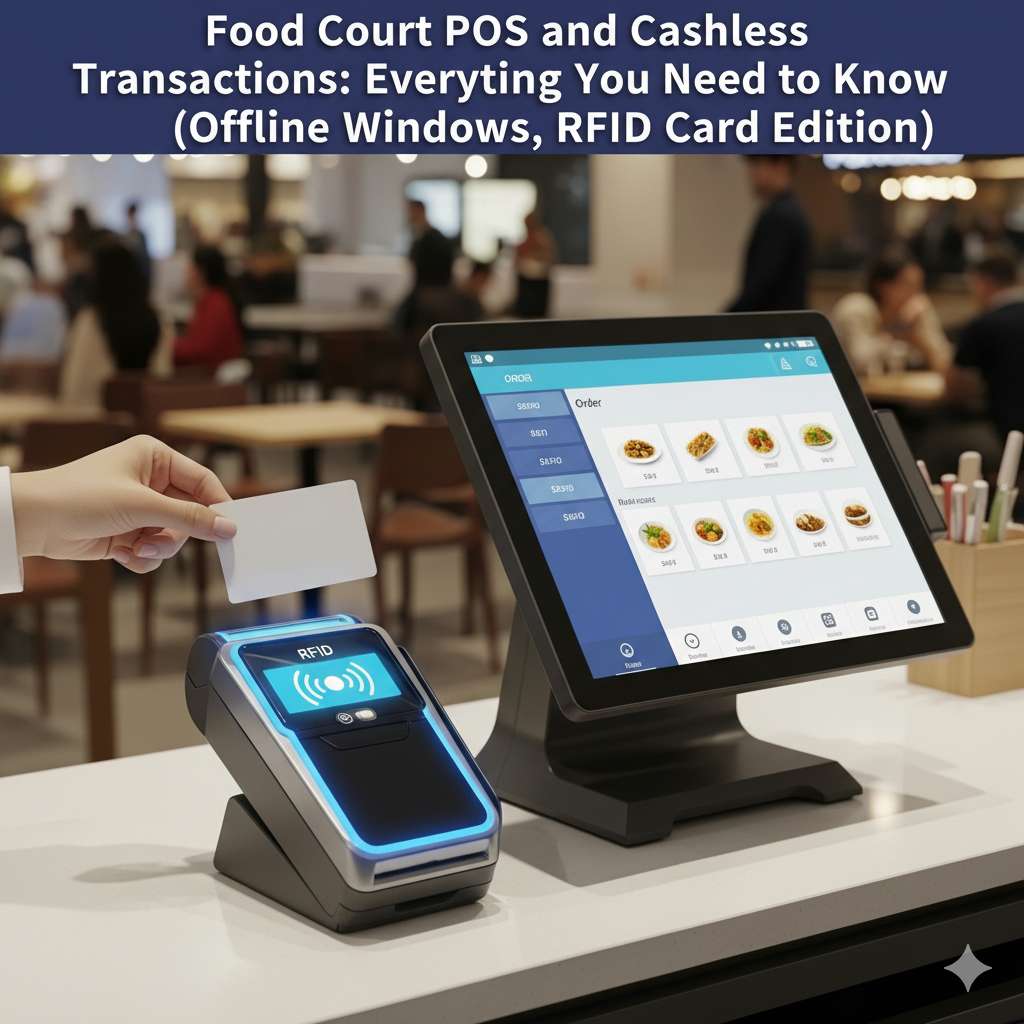Running a busy food court means dealing with long queues, multiple outlets, and constant pressure to serve customers quickly. Traditional billing methods struggle to keep up. That’s where a Food Court POS—specifically an offline Windows-based RFID card system—comes in.
In this guide, we’ll explain exactly what a Food Court POS is, why RFID cashless transactions are the future, and how your food court can benefit from adopting this technology.
What Is a Food Court POS (Offline, RFID-Based)?
A Food Court POS (Point of Sale) is a billing and payment system designed to manage multi-outlet food courts in malls, airports, colleges, and corporate cafeterias. Unlike regular POS machines, a food court POS is centralized—all outlets connect to one system for smooth billing and settlement.
Instead of relying on internet-based solutions, an offline Windows POS runs locally on PCs and servers. Customers use RFID prepaid cards to load money and pay at counters with just a tap. This ensures speed, reliability, and independence from internet downtime.
Why RFID Cashless Transactions Beat Cash (and Mobile Payments)
Food courts often face peak-hour rush, and slow payments create bottlenecks. RFID cards solve this by making transactions instant and cashless.
- Fast checkout – tap-and-pay in seconds.
- Works offline – no internet required.
- Secure & controlled – prevents theft or cash mishandling.
- Reusable cards – ideal for malls, corporates, and colleges.
Unlike QR codes or mobile wallets, RFID cards don’t depend on network connectivity, making them ideal for high-traffic areas.
Core Features of an Offline Windows Food Court POS
Centralized Billing & Control
One central server manages transactions across all outlets. Owners can monitor outlet-wise sales in real time.
RFID Card Issuance & Top-Ups
Customers buy or receive an RFID card, load money at top-up counters, and reuse it across outlets.
Fast Tap-to-Pay at Counters
Cashiers equipped with Windows POS terminals and RFID readers process payments instantly.
Reports & Settlements
Automatic reconciliation ensures transparent outlet-wise revenue sharing.
Required Hardware for an Offline RFID Food Court POS
Setting up the system involves simple, durable hardware:
- Windows POS terminal (cashier PCs)
- RFID card readers/writers
- Thermal receipt printers
- LAN switch & cabling
- Server PC for centralized data storage
This offline setup works without internet and ensures smooth operations, even in peak hours.
How RFID Cashless Transactions Work (Step by Step)
For Customers
- Buy and activate an RFID card.
- Load balance at the top-up counter.
- Order food and tap card at outlet.
- Amount deducted instantly.
- Reuse card until balance runs out.
For Food Court Management
- Track every sale in real time.
- Generate daily settlement reports.
- Distribute revenues to outlets.
- Analyze sales trends and customer spending patterns.
Traditional POS vs. Food Court POS (RFID, Offline)
| Feature | Traditional POS | Food Court POS (RFID, Offline) |
|---|---|---|
| Billing | Cash/credit at outlet only | Centralized, cashless with RFID cards |
| Speed | Slow in rush hours | Instant tap-to-pay |
| Network Dependency | High | Works offline |
| Transparency | Outlet-only data | Centralized outlet-wise reports |
Choosing the Right Food Court POS (Offline, Windows-Based)
When selecting a POS for your food court, consider:
- Scalability – Can it handle multiple outlets?
- RFID standards – MIFARE cards are industry standard.
- Database security – Reliable local SQL backups.
- Reports – Item-wise, outlet-wise, hourly data.
- Support & training – Local vendor support is crucial.
Cost & ROI of a Food Court POS
Implementing a Windows RFID POS involves:
- One-time software license
- Hardware (RFID readers, PCs, printers)
- RFID cards for customers
- Annual support/maintenance
The ROI is quick, as food courts benefit from:
- Reduced cash handling
- Faster order turnaround
- Accurate settlements
- Improved customer experience
FAQs
What is the difference between a POS and a Food Court POS?
A POS handles single-outlet billing, while a Food Court POS manages multiple outlets centrally with RFID-based cashless payments.
How do RFID prepaid cards work in food courts?
Customers load money onto cards, which act as digital wallets. Payments are deducted instantly on tap.
Is an offline Windows Food Court POS better than cloud systems?
Yes—since it runs offline, it avoids internet issues and provides reliable performance.
What hardware is needed for an RFID Food Court POS?
Windows PCs, RFID readers, printers, and a server for centralized billing.
How secure are RFID cashless transactions?
They use encrypted keys, blocking lost cards instantly, and tracking every transaction for transparency.
Conclusion: Why Food Courts Need Offline Windows RFID POS
In today’s fast-paced dining environments, speed, accuracy, and customer convenience are non-negotiable. A Food Court POS powered by RFID cards and Windows-based offline software delivers just that. It ensures seamless billing, transparent settlements, and a future-ready cashless experience.
👉 Ready to modernize your food court? Contact Advance Technology Systems




